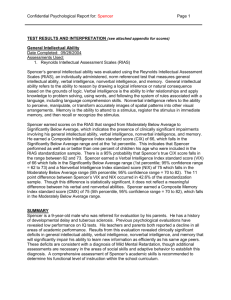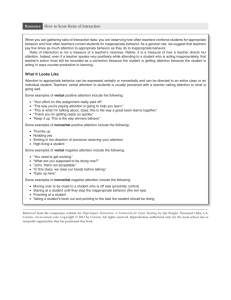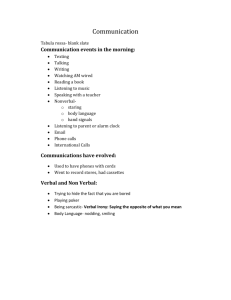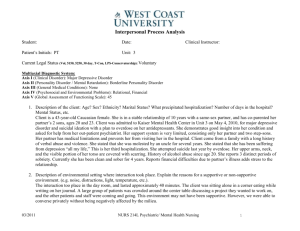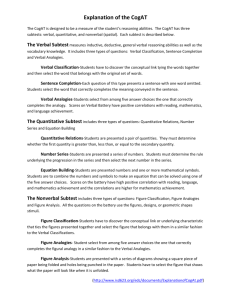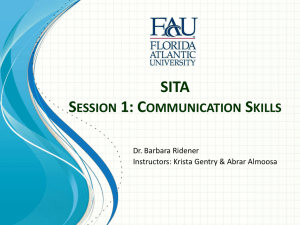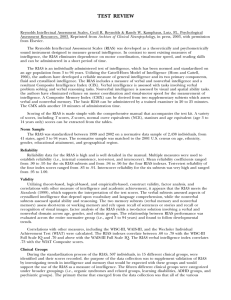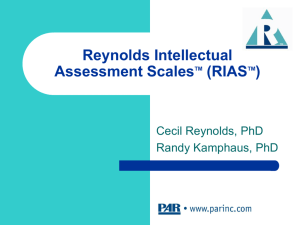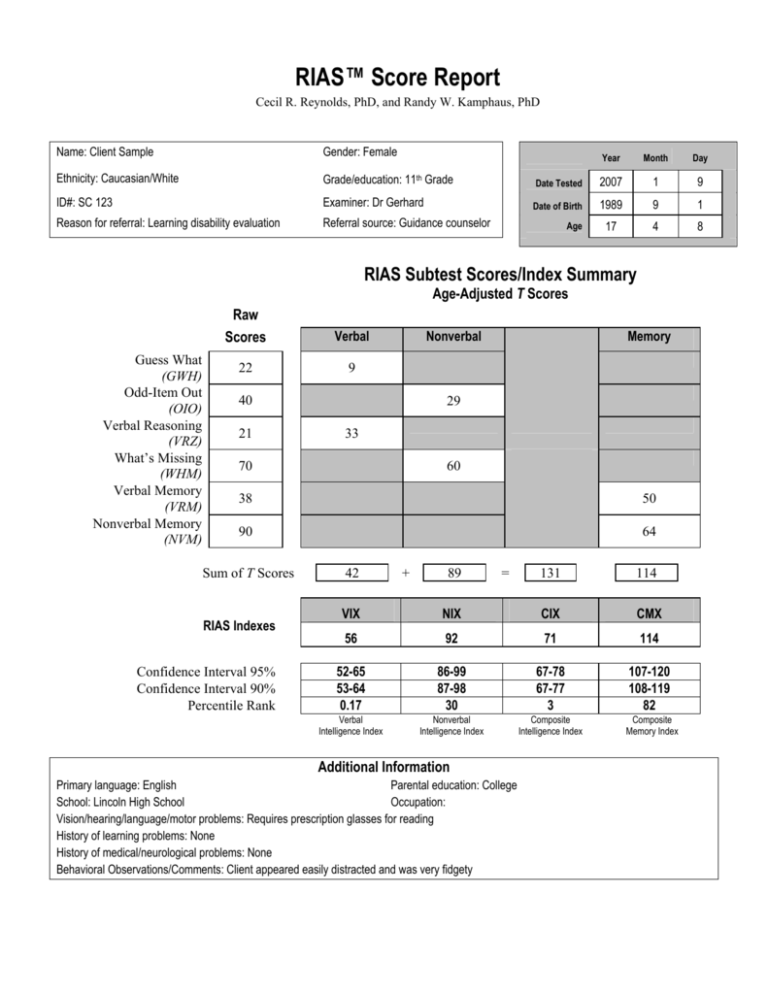
RIAS™ Score Report
Cecil R. Reynolds, PhD, and Randy W. Kamphaus, PhD
Name: Client Sample
Gender: Female
Ethnicity: Caucasian/White
Grade/education: 11th Grade
ID#: SC 123
Examiner: Dr Gerhard
Reason for referral: Learning disability evaluation
Referral source: Guidance counselor
Year
Month
Day
Date Tested
2007
1
9
Date of Birth
1989
9
1
17
4
8
Age
RIAS Subtest Scores/Index Summary
Age-Adjusted T Scores
Guess What
(GWH)
Odd-Item Out
(OIO)
Verbal Reasoning
(VRZ)
What’s Missing
(WHM)
Verbal Memory
(VRM)
Nonverbal Memory
(NVM)
Raw
Scores
Verbal
22
9
Nonverbal
40
21
Memory
29
33
70
60
38
50
90
64
Sum of T Scores
RIAS Indexes
Confidence Interval 95%
Confidence Interval 90%
Percentile Rank
42
+
89
=
131
114
VIX
NIX
CIX
CMX
56
92
71
114
52-65
53-64
0.17
86-99
87-98
30
67-78
67-77
3
107-120
108-119
82
Verbal
Intelligence Index
Nonverbal
Intelligence Index
Composite
Intelligence Index
Composite
Memory Index
Additional Information
Primary language: English
Parental education: College
School: Lincoln High School
Occupation:
Vision/hearing/language/motor problems: Requires prescription glasses for reading
History of learning problems: None
History of medical/neurological problems: None
Behavioral Observations/Comments: Client appeared easily distracted and was very fidgety
Name: Client Sample
ID#: SC 123
Test Date: 01/09/2007
Page 2 of 6
RIAS Profiles
RIAS Subtest T Scores
RIAS Indexes
Score
≥ 90
Score
≥ 90
80
Score
≥ 160
Score
≥ 160
150
150
140
140
130
130
120
120
80
70
70
NVM
WHM
60
60
CMX
110
50
50
100
110
100
VRM
NIX
40
90
90
80
80
40
VRZ
30
30
70
CIX
70
OIO
60
20
20
60
VIX
50
≤ 10
Scale GWH VRZ OIO WHM VRM NVM
Score 9
33
29
60
50
64
≤ 10
≤ 40
Index VIX
Score 56
50
≤ 40
NIX CIX CMX
92
71 114
Name: Client Sample
ID#: SC 123
Test Date: 01/09/2007
Page 3 of 6
The test scores, descriptions of performance, and other interpretive information provided in
this computer report are predicated on the following assumptions. First, it is assumed that the
various subtests were administered and scored correctly in adherence with the general and
specific administration and scoring guidelines provided in chapter 2 of the RIAS Professional
Manual (Reynolds & Kamphaus, 2003). Second, it is also assumed that the examinee was
determined to be appropriately eligible for testing by the examiner according to the guidelines
for testing eligibility provided in chapter 2 of the RIAS Professional Manual and that the
examiner was appropriately qualified to administer and score the RIAS.
This report is intended for revelation, transmission to, and use by individuals appropriately
qualified and credentialed to interpret the RIAS under the laws and regulations of their local
jurisdiction and meeting the guidelines for use of the RIAS as stated in the RIAS Professional
Manual (see chapter 2).
Client was administered the Reynolds Intellectual Assessment Scales (RIAS). The RIAS is an
individually administered measure of intellectual functioning normed for individuals between
the ages of 3 and 94 years. The RIAS contains several individual tests of intellectual problem
solving and reasoning ability that are combined to form a Verbal Intelligence Index (VIX) and
a Nonverbal Intelligence Index (NIX). The subtests that compose the VIX assess verbal
reasoning ability along with the ability to access and apply prior learning in solving languagerelated tasks. Although labeled the Verbal Intelligence Index, the VIX is also a reasonable
approximation of crystallized intelligence. The NIX comprises subtests that assess nonverbal
reasoning and spatial ability. Although labeled the Nonverbal Intelligence Index, the NIX
also provides a reasonable approximation of fluid intelligence and spatial ability. These two
indexes of intellectual functioning are then combined to form an overall Composite
Intelligence Index (CIX). By combining the VIX and the NIX into the CIX, a strong, reliable
assessment of general intelligence (g) is obtained. The CIX measures the two most important
aspects of general intelligence according to recent theories and research findings: reasoning or
fluid abilities and verbal or crystallized abilities. Each of these indexes is expressed as an
age-corrected standard score that is scaled to a mean of 100 and a standard deviation of 15.
These scores are normally distributed and can be converted to a variety of other metrics if
desired.
The RIAS also contains subtests designed to assess verbal memory and nonverbal memory.
Depending upon the age of the individual being evaluated, the verbal memory subtest consists
of a series of sentences, age-appropriate stories, or both, read aloud to the examinee. The
examinee is then asked to recall these sentences or stories as precisely as possible. The
nonverbal memory subtest consists of the presentation of pictures of various objects or
abstract designs for a period of 5 seconds. The examinee is then shown a page containing six
similar objects or figures and must discern which object or figure was previously shown. The
scores from the verbal memory and nonverbal memory subtests are combined to form a
Composite Memory Index (CMX), which provides a strong, reliable assessment of working
memory and may also provide indications as to whether or not a more detailed assessment of
memory functions may be required. In addition, the high reliability of the verbal and
nonverbal memory subtests allows them to be compared directly to each other.
On testing with the RIAS, Client earned a Composite Intelligence Index or CIX of 71. On the
RIAS, this level of performance falls within the range of scores designated as moderately
below average and exceeds the performance of 3% of individuals at Client's age. The chances
Name: Client Sample
ID#: SC 123
Test Date: 01/09/2007
Page 4 of 6
are 90 out of 100 that Client's true CIX falls within the range of scores from 67 to 77.
Client earned a Composite Memory Index (CMX) of 114, which falls within the above
average range of working memory skills and exceeds the performance of 82 out of 100
individuals Client's age. The chances are 90 out of 100 that Client's true CMX falls within the
range of scores from 108 to 119.
Although the CIX is a good estimate of Client's general intelligence, a statistically significant
discrepancy exists between her NIX of 92 and her VIX of 56, demonstrating better developed nonverbal
intelligence or spatial abilities. The magnitude of the difference observed between these two scores is
potentially important and should be considered when drawing conclusions about Client's current status.
A difference of this size is relatively uncommon, occurring in only 1.20% of cases in the general
population. In such cases, interpretation of the CIX or general intelligence score may be of less value
than viewing Client's verbal and nonverbal abilities separately.
When compared to overall intellectual ability as measured on the RIAS and as reflected in
Client's CIX, it can be seen that her CIX falls significantly below her CMX. This indicates
that Client is able to use immediate recall and working memory functions at a level that
significantly exceeds her ability to engage in intellectual problem solving and general
reasoning tasks. The magnitude of the difference seen in this instance may take on special
diagnostic significance due to its relative infrequency in the population of normal individuals.
A difference between CIX and CMX of this magnitude occurs in only 1.30% of the
population.
Within the subtests making up the CMX, Client's performance in the nonverbal memory
domain significantly exceeded her level of performance within the verbal memory domain.
This difference is reliable and indicates that Client functions at a significantly higher level
when asked to use recall or engage in working memory tasks that are easily adapted to
nonverbal and visual-spatial strategies, as opposed to tasks that are best suited to verbal
linguistic strategies. Although most likely representing a real difference in Client's abilities in
these two areas, the magnitude of this difference is relatively common, occurring in 38.80% of
the population at Client's age.
Subtest Norm Referenced Interpretations
Guess What
The Guess What subtest measures vocabulary knowledge in combination with reasoning skills that
are predicated on language development and acquired knowledge. On testing with the RIAS, Client
earned a T score of 9 on Guess What.
Odd Item Out
Odd-Item Out measures analytical reasoning abilities within the nonverbal domain. On testing with
the RIAS, Client earned a T score of 29 on Odd-Item Out.
Verbal Reasoning
Verbal Reasoning measures analytical reasoning abilities within the verbal domain. English
vocabulary knowledge is also required. On testing with the RIAS, Client earned a T score of 33 on
Verbal Reasoning.
Name: Client Sample
ID#: SC 123
Test Date: 01/09/2007
Page 5 of 6
What’s Missing
What’s Missing measures spatial and visualization abilities. On testing with the RIAS, Client
earned a T score of 60 on What’s Missing.
Verbal Memory
Verbal Memory measures the ability to encode, briefly store, and recall information in the verbal
domain. English vocabulary knowledge is also required. On testing with the RIAS, Client earned a
T score of 50 on Verbal Memory.
Nonverbal Memory
Nonverbal Memory measures the ability to encode, briefly store, and recall information in the
nonverbal and spatial domains. On testing with the RIAS, Client earned a T score of 64 on
Nonverbal Memory.
Name: Client Sample
ID#: SC 123
Test Date: 01/09/2007
Page 6 of 6
RIAS Extended Score Summary Table
Score
GWH OIO VRZ WHM VRM NVM
VIX
NIX
CIX
CMX
Raw score
22
40
21
70
38
90
T score
9
29
33
60
50
64
21
45
31
59
1.00
0.00
1.40
-2.93
-0.53
-1.93
0.93
13
10
14
Sum of subtest
T scores
42
89
131
114
Index score
56
92
71
114
Percentile rank
0.17
30
3
82
90% confidence
interval
53-64
87-98
67-77
108-119
95% confidence
interval
52-65
86-99
67-78
107-120
NCE
1
39
9
70
Stanine
1
4
1
7
z score ≤-4.00 -2.10 -1.70
Subtest
scaled score
T score:
z score:
Subtest scaled score:
Index score:
NCE:
Stanine:
mean=50
mean=0
mean=10
mean=100
mean=50
mean=5
≤1
4
5
SD=10
SD=1
SD=3
SD=15
SD=21.06
SD=2
PAR Psychological Assessment Resources, Inc.•16204 N. Florida Ave•Lutz, FL 33549 www.parinc.com
Copyright 1998, 1999, 2002, 2003 by Psychological Assessment Resources, Inc. All rights reserved. May not be reproduced in whole or in
part in any form or by any means without written permission of Psychological Assessment Resources, Inc.
Version 1.30.037


